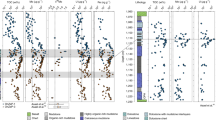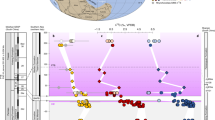Abstract
Widespread anoxia in the ocean is frequently invoked as a primary driver of mass extinction as well as a long-term inhibitor of evolutionary radiation on early Earth. In recent biogeochemical studies it has been hypothesized that oxygen deficiency was widespread in subsurface water masses of later Cambrian oceans1,2, possibly influencing evolutionary events during this time1,2,3. Physical evidence of widespread anoxia in Cambrian oceans has remained elusive and thus its potential relationship to the palaeontological record remains largely unexplored. Here we present sulphur isotope records from six globally distributed stratigraphic sections of later Cambrian marine rocks (about 499 million years old). We find a positive sulphur isotope excursion in phase with the Steptoean Positive Carbon Isotope Excursion (SPICE), a large and rapid excursion in the marine carbon isotope record, which is thought to be indicative of a global carbon cycle perturbation4,5. Numerical box modelling of the paired carbon sulphur isotope data indicates that these isotope shifts reflect transient increases in the burial of organic carbon and pyrite sulphur in sediments deposited under large-scale anoxic and sulphidic (euxinic) conditions. Independently, molybdenum abundances in a coeval black shale point convincingly to the transient spread of anoxia. These results identify the SPICE interval as the best characterized ocean anoxic event in the pre-Mesozoic ocean and an extreme example of oxygen deficiency in the later Cambrian ocean. Thus, a redox structure similar to those in Proterozoic oceans6,7,8 may have persisted or returned in the oceans of the early Phanerozoic eon. Indeed, the environmental challenges presented by widespread anoxia may have been a prevalent if not dominant influence on animal evolution in Cambrian oceans.
This is a preview of subscription content, access via your institution
Access options
Subscribe to this journal
Receive 51 print issues and online access
$199.00 per year
only $3.90 per issue
Buy this article
- Purchase on Springer Link
- Instant access to full article PDF
Prices may be subject to local taxes which are calculated during checkout




Similar content being viewed by others
References
Hough, M. L. et al. A major sulphur isotope event at c. 510 Ma: a possible anoxia–extinction–volcanism connection during the Early–Middle Cambrian transition? Terra Nova 18, 257–263 (2006)
Hurtgen, M. T., Pruss, S. B. & Knoll, A. H. Evaluating the relationship between the carbon and sulfur cycles in the later Cambrian ocean: an example from the Port au Port Group, western Newfoundland, Canada. Earth Planet. Sci. Lett. 281, 288–297 (2009)
Zhuravlev, A. & Wood, R. Anoxia as the cause of the mid-Early Cambrian (Botomian) extinction event. Geology 24, 311–314 (1996)
Saltzman, M. et al. A global carbon isotope excursion (SPICE) during the Late Cambrian: relation to trilobite extinctions, organic-matter burial and sea level. Palaeogeogr. Palaeoclimatol. Palaeoecol. 162, 211–223 (2000)
Saltzman, M. R. et al. The Late Cambrian SPICE (δ13C) Event and the Sauk II-SAUK III Regression: new evidence from Laurentian basins in Utah, Iowa and Newfoundland. J. Sedim. Res. 74, 366–377 (2004)
Canfield, D. E. A new model for Proterozoic ocean chemistry. Nature 396, 450–453 (1998)
Poulton, S. W., Fralick, P. W. & Canfield, D. E. The transition to a sulphidic ocean ∼1.84 billion years ago. Nature 431, 173–177 (2004)
Scott, C. et al. Tracing the stepwise oxygenation of the Proterozoic ocean. Nature 452, 456–459 (2008)
Brasier, M. D., Corfield, R. M., Derry, L. A., Rozanov, A. Y. & Zhuravlev, A. Y. Multiple δ13C excursions spanning the Cambrian explosion to the Botomian crisis in Siberia. Geology 22, 455–458 (1994)
Saltzman, M. R., Runnegar, B. & Lohmann, K. C. Carbon isotope stratigraphy of Upper Cambrian (Steptoean Stage) sequences of the eastern Great Basin: record of a global oceanographic event. Geol. Soc. Am. Bull. 110, 285–297 (1998)
Montanez, I. P., Osleger, D. A., Banner, J. L., Mack, L. E. & Musgrove, M. Evolution of the Sr and C isotope composition of Cambrian Oceans. GSA Today 10, 1–7 (2000)
Palmer, A. The biomere problem: evolution of an idea. J. Paleontol. 58, 599–611 (1984)
Peng, S. et al. Global standard stratotype—section and point of the Furongian series and Paibian stage Cambrian. Lethaia 37, 365–379 (2004)
Brennan, S. T., Lowenstein, T. K. & Horita, J. Seawater chemistry and the advent of biocalcification. Geology 32, 473–476 (2004)
Gill, B. C., Lyons, T. W. & Saltzman, M. R. Parallel, high-resolution carbon and sulfur isotope records of the evolving Paleozoic marine sulfur reservoir. Palaeogeogr. Palaeoclimatol. Palaeoecol. 256, 156–173 (2007)
Berner, R. Sedimentary pyrite formation: an update. Geochim. Cosmochim. Acta 48, 605–615 (1984)
Neretin, L. N., Volkov, I. I., Böttcher, M. E. & Grinenko, V. A. A sulfur budget for the Black Sea anoxic zone. Deep Sea Res. I 48, 2569–2593 (2001)
Emerson, S. & Huested, S. Ocean anoxia and the concentrations of molybdenum and vanadium in seawater. Mar. Chem. 34, 177–196 (1991)
Algeo, T. J. & Lyons, T. W. Mo–total organic carbon covariation in modern anoxic marine environments: Implications for analysis of paleoredox and paleohydrographic conditions. Paleoceanography 21, PA1016 (2006)
Algeo, T. J. Can marine anoxic events draw down the trace element inventory of seawater? Geology 32, 1057–1060 (2004)
Arthur, M. A., Dean, W. E. & Pratt, L. M. Geochemical and climatic effects of increased marine organic carbon burial at the Cenomanian/Turonian boundary. Nature 335, 714–717 (1988)
Adams, D. D., Hurtgen, M. T. & Sageman, B. B. Volcanic triggering of a biogeochemical cascade during Oceanic Anoxic Event 2. Nature Geosci. 3, 1–4 (2010)
Wignall, P. B. & Twitchett, R. J. Oceanic anoxia and the end Permian mass extinction. Science 272, 1155–1158 (1996)
Berry, W. B. N. & Wilde, P. Progressive ventilation of the oceans; an explanation for the distribution of the lower Paleozoic black shales. Am. J. Sci. 278, 257–275 (1978)
Bambach, R. K., Knoll, A. H. & Wang, S. C. Origination, extinction, and mass depletions of marine diversity. Paleobiology 30, 522–542 (2004)
Palmer, A. R. Biomere: a new kind of biostratigraphic unit. J. Paleontol. 39, 149–153 (1965)
Scotese, C. R. Atlas of Earth History (PALEOMAP Project, 2001)
Ahlberg, P. et al. Cambrian high-resolution biostratigraphy and carbon isotope chemostratigraphy in Scania, Sweden: first record of the SPICE and DICE excursions in Scandinavia. Lethaia 42, 2–16 (2008)
Lyons, T. W. & Severmann, S. A critical look at iron paleoredox proxies: new insights from modern euxinic marine basins. Geochim. Cosmochim. Acta 70, 5698–5722 (2006)
Raiswell, R., Buckley, F., Berner, R. A. & Anderson, T. F. Degree of pyritization of iron as a paleoenvironmental indicator of bottom-water oxygenation. J. Sedim. Res. 58, 812–819 (1988)
Acknowledgements
NSF-EAR and NASA Astrobiology provided funding. Fieldwork and sample collection were aided by S. Bates, L. Bongers, H. Dayton, S. Mason, P. McGoldrick, J. Owens, C. Seeger and E. Starbuck. Sulphur isotope analyses were aided by S. Bates and W. Gilhooly. We thank P. Ahlberg and M. Eriksson for allowing access to the Andrarum no. 3 drill core. Discussions with G. Love, N. Hughes, D. Johnston, P. Cohen and T. Dahl improved the manuscript.
Author information
Authors and Affiliations
Contributions
B.C.G., T.W.L., M.R.S. and S.A.Y. collected samples used in this study. B.C.G. did the chemical analyses and collected mass spectrometer and ICP-MS data. B.C.G. and L.R.K. built the geochemical box model. B.C.G. wrote the manuscript, with contributions from T.W.L., A.H.K. and L.R.K. All the authors contributed to discussions and interpretations of the data.
Corresponding author
Ethics declarations
Competing interests
The authors declare no competing financial interests.
Supplementary information
Supplementary Information
This file contains Supplementary Samples and Geological Settings, Supplementary Methods, additional references, Supplementary Tables 1-6 and Supplementary Figures 1-14 with legends. (PDF 2979 kb)
Rights and permissions
About this article
Cite this article
Gill, B., Lyons, T., Young, S. et al. Geochemical evidence for widespread euxinia in the Later Cambrian ocean. Nature 469, 80–83 (2011). https://doi.org/10.1038/nature09700
Received:
Accepted:
Published:
Issue Date:
DOI: https://doi.org/10.1038/nature09700
This article is cited by
-
Redox conditions of Early Cambrian Ocean as deciphered from multi-proxy geochemical and isotopic studies of Proto-Tethys carbonaceous sediments from Outer Lesser Himalaya, India
Journal of Earth System Science (2024)
-
Global and regional controls on carbon-sulfur isotope cycling during SPICE event in south China
Frontiers of Earth Science (2023)
-
Carbon Isotope from Shallow Marine System in North China: Implications for Stratigraphical Correlation and Sea-Level Changes in Cambrian
Journal of Earth Science (2023)
-
Synchronizing rock clocks in the late Cambrian
Nature Communications (2022)
-
Submarine metalliferous carbonate mounds in the Cambrian of the Baltoscandian Basin induced by vent networks and water column stratification
Scientific Reports (2022)
Comments
By submitting a comment you agree to abide by our Terms and Community Guidelines. If you find something abusive or that does not comply with our terms or guidelines please flag it as inappropriate.



